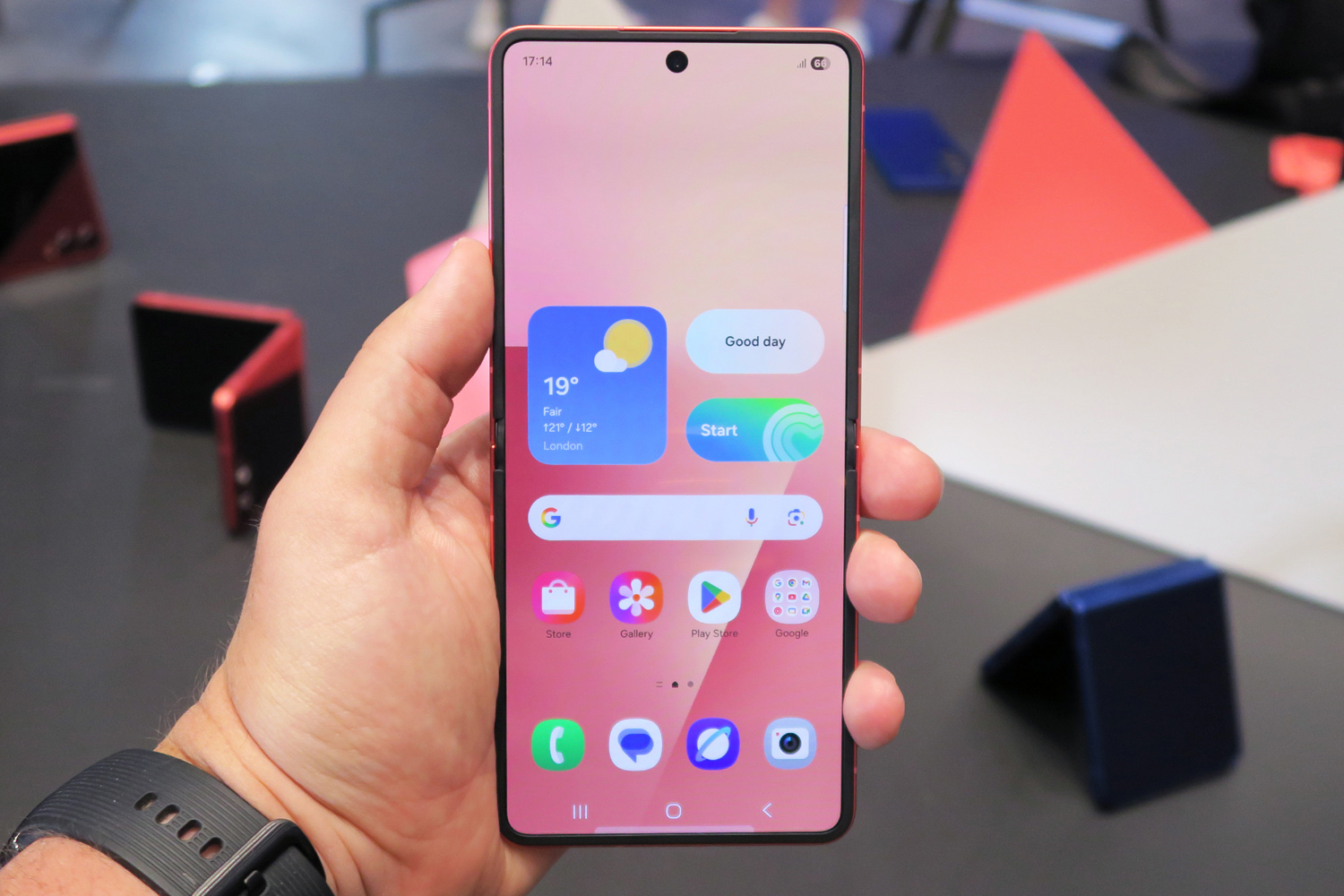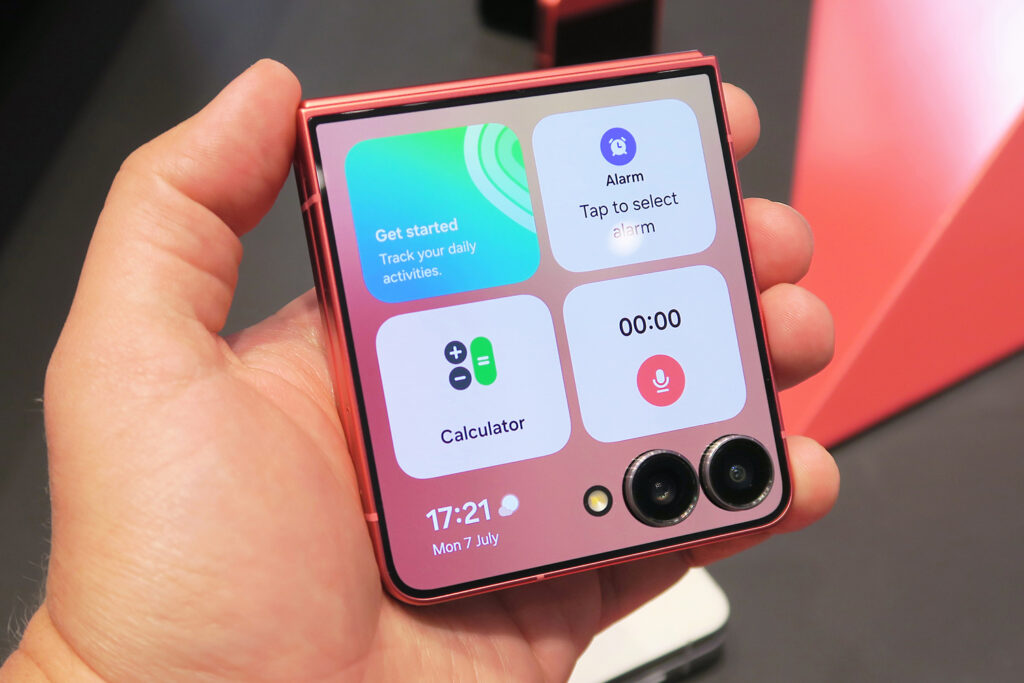Introduction
While I think traditional smartphones with square sides generally look great, those aesthetics and ergonomics haven’t always translated well to clamshell foldables. Until I held the Galaxy Z Flip 7, I couldn’t figure out why. With Samsung’s new compact Flip, however, I realised it was the sheer thickness that was holding these phones back.
In person, the new Flip 7 feels like a major technical advancement; massaging the series’ familiar form with slightly larger displays than before, paired to a notably thinner profile. A 13.7mm profile that’s even more prominent when placed alongside the first FE entry in the Flip series. The Galaxy Z Flip 7 FE – which appears to be a repackaged Z Flip 6 with a few hardware tweaks – is positively portly in comparison at 14.9mm.
Both phones are up for pre-order today, and go on sale from July 25. Prices start at £1049 for the 256GB Flip 7 and £1149 for the 512GB variant. The Flip 7 FE lands at £849 for 128GB, and rises to £909 for the 256GB model.

A new degree of thinness isn’t only found in the Flip 7’s aspect though. It’s also around the 4.1in cover display, which has the thinnest bezels ever on a Galaxy phone at 1.25mm. These surround a beautifully bright AMOLED panel that peaks at 2600 nits, and looks super-smooth at 120Hz.
Samsung has taken a leaf out of Motorola’s book here, running the pixels right up to the Flip 7’s twin outer cameras. This also grants functional benefits, like red accents around the lenses when recording using the outer screen, yellow when using the timer, or white when adjust settings. It’s a cosmetic and practical upgrade that feels long overdue, but I’m glad it’s here.
Both the outer screen and back panel are protected by Gorilla Glass Victus 2, while Samsung claims to have also upped its foldable’s ingress protection (especially against dust); now promising IP48 protection at a circuit board level.
All the new hardware looks delicious, especially in the new Blue Shadow and Coral Red colours, but it’d be for nowt if Samsung hadn’t also expanded the phone’s functionality.
The Flip 7 is the first of its kind to get DeX support, offering a desktop-like experience when paired with a mouse, keyboard, and external display. I never understood why Z Fold phones got this but Z Flips didn’t, considering the Fold’s unique form factor already allowed for greater productivity than a conventional phone. Now the Z Flip 7 has been rendered one of the smallest work devices around. That’s pretty far removed from its roots as a device aimed solely at influencers and the fashion-conscious.
Powering DeX – and the rest of the phone’s flagship-grade experience – is one of Samsung’s own Exynos 2500 chipsets, paired with 12GB of RAM. The Flip 7 FE gets a step-down Exynos 2400 and 8GB of memory. Samsung has also managed to squeeze a notably larger battery inside the Z Flip 7. At 4300mAh, you’re getting almost as much juice here as you’ll find on the far pricier Galaxy Z Fold 7.
Not getting the same 8-core Snapdragon 8 Elite for Galaxy chipset as the Fold 7 might be considered a disappointment, but based on my initial impressions, it’s clearly now slouch. That said, with the thinner profile – and Exynos’ mixed history when it comes to performance and efficiency – I’m curious to see how the Flip 7 holds up under heavy loads, particularly where thermal performance is concerned.
The Flip 7 arrives running Samsung’s latest One UI 8 user experience atop Android 16. It gains features like the Now Bar and Now Brief, as well as enhanced Google Gemini support, all of which can be accessed on the phone’s cover display. I liked Samsung’s clean widget implementation before, but think users will massively appreciate the convenience of Now Bar and Gemini Live on that outer screen. Not least because of the larger, clearer, more glanceable panel you now get to look at.
One area I would have liked to have seen greater improvement is in the cameras. Despite slimming the sensors down to fit into the Flip 7’s new tighter dimensions, the phone appears to run with the same 50MP main, 12MP ultra-wide and 10MP selfie snapper as the last few generations of Flip. The only notable additions are a zoom slider and auto-zoom to the main camera when in Flex Mode.
10-bit HDR support persists, which helps with dynamic range, colour depth and low light performance in shots, and that large main sensor allows for a little extra versatility with its ‘hybrid 2x zoom’ support.
With Samsung finally managing to squeeze a 200MP sensor in its latest Fold, though, I’m left wondering – like DeX – when it might be the Flip’s turn.
Samsung Galaxy Z Flip 7 technical specifications
| Screen | 4.1in AMOLED (outer) 6.9in AMOLED (inner) |
| CPU | Samsung Exynos 2500 |
| Memory | 12GB RAM |
| Cameras | 50MP + 12MP ultrawide rear 10MP front |
| Storage | 256GB/512GB |
| Operating system | Android 16 w/ One UI 8 |
| Battery | 4300mAh |
| Dimensions | 75x86x13.7mm (folded) 75x167x6.5mm (unfolded) 188g |
Read the full article here
